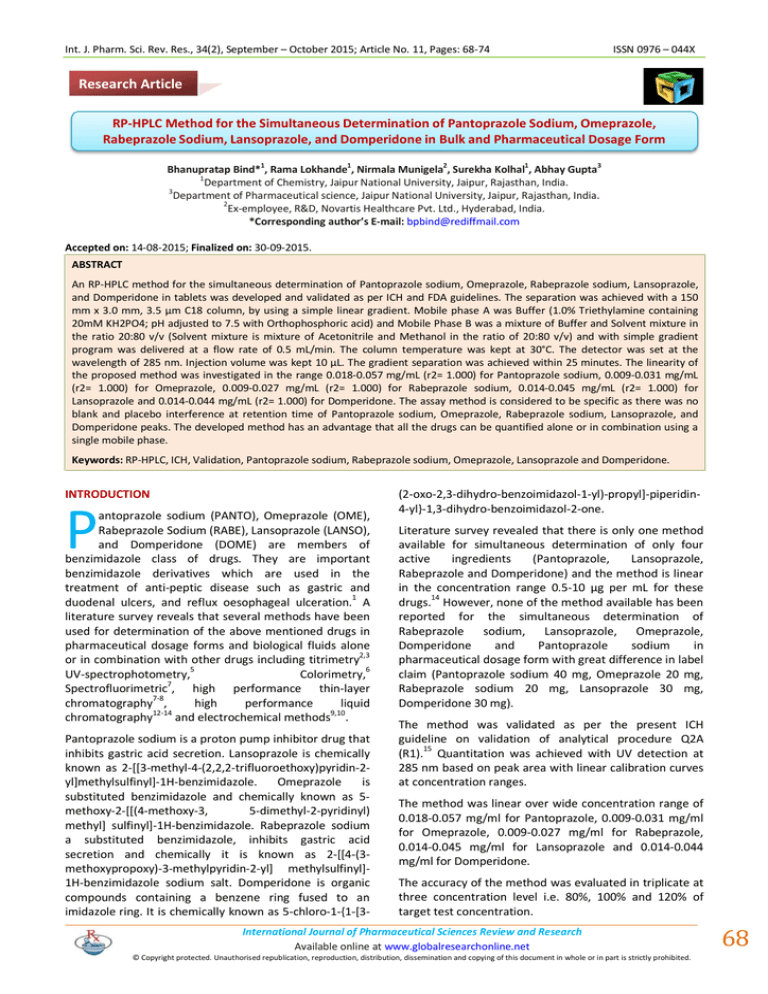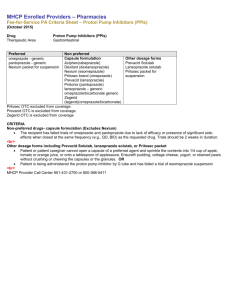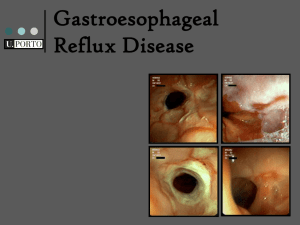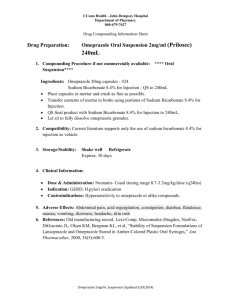Document 13310657
advertisement

Int. J. Pharm. Sci. Rev. Res., 34(2), September – October 2015; Article No. 11, Pages: 68-74
ISSN 0976 – 044X
Research Article
RP-HPLC Method for the Simultaneous Determination of Pantoprazole Sodium, Omeprazole,
Rabeprazole Sodium, Lansoprazole, and Domperidone in Bulk and Pharmaceutical Dosage Form
1
1
2
1
3
Bhanupratap Bind* , Rama Lokhande , Nirmala Munigela , Surekha Kolhal , Abhay Gupta
1
Department of Chemistry, Jaipur National University, Jaipur, Rajasthan, India.
3
Department of Pharmaceutical science, Jaipur National University, Jaipur, Rajasthan, India.
2
Ex-employee, R&D, Novartis Healthcare Pvt. Ltd., Hyderabad, India.
*Corresponding author’s E-mail: bpbind@rediffmail.com
Accepted on: 14-08-2015; Finalized on: 30-09-2015.
ABSTRACT
An RP-HPLC method for the simultaneous determination of Pantoprazole sodium, Omeprazole, Rabeprazole sodium, Lansoprazole,
and Domperidone in tablets was developed and validated as per ICH and FDA guidelines. The separation was achieved with a 150
mm x 3.0 mm, 3.5 µm C18 column, by using a simple linear gradient. Mobile phase A was Buffer (1.0% Triethylamine containing
20mM KH2PO4; pH adjusted to 7.5 with Orthophosphoric acid) and Mobile Phase B was a mixture of Buffer and Solvent mixture in
the ratio 20:80 v/v (Solvent mixture is mixture of Acetonitrile and Methanol in the ratio of 20:80 v/v) and with simple gradient
program was delivered at a flow rate of 0.5 mL/min. The column temperature was kept at 30°C. The detector was set at the
wavelength of 285 nm. Injection volume was kept 10 µL. The gradient separation was achieved within 25 minutes. The linearity of
the proposed method was investigated in the range 0.018-0.057 mg/mL (r2= 1.000) for Pantoprazole sodium, 0.009-0.031 mg/mL
(r2= 1.000) for Omeprazole, 0.009-0.027 mg/mL (r2= 1.000) for Rabeprazole sodium, 0.014-0.045 mg/mL (r2= 1.000) for
Lansoprazole and 0.014-0.044 mg/mL (r2= 1.000) for Domperidone. The assay method is considered to be specific as there was no
blank and placebo interference at retention time of Pantoprazole sodium, Omeprazole, Rabeprazole sodium, Lansoprazole, and
Domperidone peaks. The developed method has an advantage that all the drugs can be quantified alone or in combination using a
single mobile phase.
Keywords: RP-HPLC, ICH, Validation, Pantoprazole sodium, Rabeprazole sodium, Omeprazole, Lansoprazole and Domperidone.
INTRODUCTION
P
antoprazole sodium (PANTO), Omeprazole (OME),
Rabeprazole Sodium (RABE), Lansoprazole (LANSO),
and Domperidone (DOME) are members of
benzimidazole class of drugs. They are important
benzimidazole derivatives which are used in the
treatment of anti-peptic disease such as gastric and
1
duodenal ulcers, and reflux oesophageal ulceration. A
literature survey reveals that several methods have been
used for determination of the above mentioned drugs in
pharmaceutical dosage forms and biological fluids alone
2,3
or in combination with other drugs including titrimetry
5
UV-spectrophotometry,
Colorimetry,6
7
Spectrofluorimetric , high performance thin-layer
7-8
chromatography ,
high
performance
liquid
12-14
9,10
chromatography
and electrochemical methods .
Pantoprazole sodium is a proton pump inhibitor drug that
inhibits gastric acid secretion. Lansoprazole is chemically
known as 2-[[3-methyl-4-(2,2,2-trifluoroethoxy)pyridin-2yl]methylsulfinyl]-1H-benzimidazole.
Omeprazole
is
substituted benzimidazole and chemically known as 5methoxy-2-[[(4-methoxy-3,
5-dimethyl-2-pyridinyl)
methyl] sulfinyl]-1H-benzimidazole. Rabeprazole sodium
a substituted benzimidazole, inhibits gastric acid
secretion and chemically it is known as 2-[[4-(3methoxypropoxy)-3-methylpyridin-2-yl] methylsulfinyl]1H-benzimidazole sodium salt. Domperidone is organic
compounds containing a benzene ring fused to an
imidazole ring. It is chemically known as 5-chloro-1-{1-[3-
(2-oxo-2,3-dihydro-benzoimidazol-1-yl)-propyl]-piperidin4-yl}-1,3-dihydro-benzoimidazol-2-one.
Literature survey revealed that there is only one method
available for simultaneous determination of only four
active
ingredients
(Pantoprazole,
Lansoprazole,
Rabeprazole and Domperidone) and the method is linear
in the concentration range 0.5-10 µg per mL for these
14
drugs. However, none of the method available has been
reported for the simultaneous determination of
Rabeprazole
sodium, Lansoprazole, Omeprazole,
Domperidone
and
Pantoprazole
sodium
in
pharmaceutical dosage form with great difference in label
claim (Pantoprazole sodium 40 mg, Omeprazole 20 mg,
Rabeprazole sodium 20 mg, Lansoprazole 30 mg,
Domperidone 30 mg).
The method was validated as per the present ICH
guideline on validation of analytical procedure Q2A
15
(R1). Quantitation was achieved with UV detection at
285 nm based on peak area with linear calibration curves
at concentration ranges.
The method was linear over wide concentration range of
0.018-0.057 mg/ml for Pantoprazole, 0.009-0.031 mg/ml
for Omeprazole, 0.009-0.027 mg/ml for Rabeprazole,
0.014-0.045 mg/ml for Lansoprazole and 0.014-0.044
mg/ml for Domperidone.
The accuracy of the method was evaluated in triplicate at
three concentration level i.e. 80%, 100% and 120% of
target test concentration.
International Journal of Pharmaceutical Sciences Review and Research
Available online at www.globalresearchonline.net
© Copyright protected. Unauthorised republication, reproduction, distribution, dissemination and copying of this document in whole or in part is strictly prohibited.
68
© Copyright pro
Int. J. Pharm. Sci. Rev. Res., 34(2), September – October 2015; Article No. 11, Pages: 68-74
MATERIALS AND METHODS
ISSN 0976 – 044X
An Waters X Bridge C18 column (150 mm X 3.0 mm id and
3.5 µm particle size) was used as the stationary phase.
Chemicals and Reagents
Rabeprazole sodium (RABE), Omeprazole (OME),
Lansoprazole (LANSO), Domperidone (DOME) and
Pantoprazole sodium (PANTO) were obtained from Bioleo
Labs and K.P Labs, Hyderabad, India. Excipients for
preparation of placebo were obtained from K.P. LABS,
Hyderabad, India. Branded formulation of Lansoprazole,
Pantoprazole sodium, Rabeprazole sodium, Omeprazole,
and Domperidone were procured from local market.
HPLC grade, methanol and acetonitrile were obtained
from Merck Chemicals (Mumbai, India). HPLC grade
Orthophosphoric acid (88%) was from Merck (Mumbai,
India). Triethylamine was obtained from Merck Chemicals
(Mumbai, India), HPLC grade water was prepared using a
Milli-Q system (Millipore). Nylon syringe filters (0.45 µm)
were from Millipore (Mumbai, India). All the other used
reagents were of analytical grade.
Selection of UV wavelength
10ppm solution of each Lansoprazole, Pantoprazole
sodium, Omeprazole, Rabeprazole sodium and
Domperidone was prepared separately in methanol. UV
scan of the above solutions were carried out over a
wavelength range of 200–400 nm by using the Shimadzu
UV spectrophotometer, Model- UV-1800. The detection
wavelength was set at 228 nm because all the
components had higher responses. An overlaid UV
absorption spectrum is shown in Figure-1.
Mobile phase A was Buffer pH-7.5 (1.0% Triethylamine
containing 20mM KH2PO4; pH adjusted to 7.5 with
Orthophosphoric acid) and Mobile Phase B was, Mixture
of Buffer pH-7.5 and Solvent mixture in the ratio of 20:80
v/v (Solvent mixture is mixture of Acetonitrile and
Methanol in the ratio of 20:80 v/v) with simple gradient
program (0-3 min :: MP-A : 50-50; 3-7 min :: MP-A : 50-45;
7-20min :: MP-A : 45-10) ; 20-21 min :: MP-A : 10-50; 2125 min :: MP-A : 50-50; was delivered at a flow rate of 0.5
mL/min.
The mobile phase was filtered through a 0.45 µ
membrane filter and sonicated for 10 min. The column
temperature was kept at 30°C. The detector was set at
the wavelength of 285 nm. Injection volume was kept 10
µL.
Solutions and sample preparation
For the system suitability test, the solution contains
Rabeprazole (0.02 mg/mL), Lansoprazole (0.03 mg/mL),
Omeprazole (0.02 mg/mL), Pantoprazole (0.04 mg/mL)
and Domperidone (0.03 mg/mL).
For the linearity studies, variable weight of compounds
was weighed and diluted with the solvent to yield
solutions at different concentration.
For test sample solution, 5 tablets were weighed and
transferred to 500 mL volumetric flask. Added 100 mL of
methanol to this mixture sonicated the solution for
approximately 10 minutes and vortex for about 10
minutes. Cooled to room temperature and diluted to the
volume with diluent.
Further 5 mL aliquot of this sample stock solution was
transferred to 100 mL volumetric flask and diluted to the
mark with diluent to obtain a test solution of Rabeprazole
(0.02 mg/mL), Lansoprazole (0.03 mg/mL), Omeprazole
(0.02 mg/mL), Pantoprazole (0.04 mg/mL) and
Domperidone (0.03 mg/mL). The solution was filtered
through Nylon 0.45 µm membrane filter.
10 µL of these solutions were injected into the HPLC
system and the peak area was recorded from the
respective chromatogram.
Calculation
Figure 1: Overlaid UV absorption spectrum of
Lansoprazole, Pantoprazole sodium, Omeprazole,
Rabeprazole sodium and Domperidone.
HPLC instruments and analytical conditions
Chromatographic separation was achieved using HPLC
System (Waters Alliance 2695 Separation Module)
containing binary solvent manager, an autosampler and
UV detector. The output signal was monitored and
processed using Empower software.
All active ingredients were quantified with the following
calculation:
%
=
×
×
× 100
RESULTS AND DISCUSION
Literature survey revealed that, no method is available in
the official compendia using HPLC for analyzing
Lansoprazole, Pantoprazole sodium, Omeprazole,
Rabeprazole sodium and Domperidone in dosage forms.
The present proposed method was compared with the
reported method in the literature and comparison is
International Journal of Pharmaceutical Sciences Review and Research
Available online at www.globalresearchonline.net
© Copyright protected. Unauthorised republication, reproduction, distribution, dissemination and copying of this document in whole or in part is strictly prohibited.
69
© Copyright pro
Int. J. Pharm. Sci. Rev. Res., 34(2), September – October 2015; Article No. 11, Pages: 68-74
shown in Table-1. The complete separation of the
analytes was accomplished in less than 25 min and the
method can be successfully applicable to perform routine
ISSN 0976 – 044X
analysis of Lansoprazole, Pantoprazole sodium,
Omeprazole, Rabeprazole sodium and Domperidone in
bulk and in commercially available dosage forms.
Table 1 Comparison of the performance characteristics of the present method with the published methods
S.No.
Method
Reagents
Detection Wavelength/
Runtime
Linearity (mg/mL)
Remark
Reference
1
HPLC
Dipotassium
hydrogen
phosphate,
Acetonitrile,
Methanol, Orthophosphoric
acid
280 nm / 10 min
0.001 to 0.01 mg/mL for
both pantoprazole and
Rabeprazole, 0.00075 to
0.0075mg/ml
for
Lansoprazole and 0.0005
to 0.005 mg/m for
Domperidone
Omeprazole was not
analysed and method
development
and
forced
degradation
study was performed
only
n
individual
component
[14]
2
HPLC
Potassium
dihydrogen
orthophosphate,
Triethylamine, Acetonitrile,
Methanol, Orthophosphoric
acid
285 nm / 25 min
0.018-0.057 mg/ml for
Pantoprazole, 0.009-0.031
mg/ml for Omeprazole,
0.009- 0.027 mg/ml for
Rabeprazole, 0.014-0.045
mg/ml for Lansoprazole
and 0.014-0.044 mg/ml for
Domperidone.
Wide linearity range
and also study was
performed
in
combined form.
Present
work
Table 2: System suitability
Reference solution Peak Area, for n=6
Pantoprazole sodium
Omeprazole
0.65
0.16
%RSD
Acceptance Criteria
Rabeprazole
sodium
Lansoprazole sodium
Domperidone
0.68
0.12
0.15
8.34
17.92
1.08
1.12
20190
56811
Not more than 2.0%
Reference solution Peak resolution, for n=6
Resolution
-
3.48
2.61
Acceptance Criteria
Not less than 2.0
Reference solution Peak Symmetry factor, for n=6
Symmetry Factor
1.12
1.08
1.12
Acceptance Criteria
Should be between 0.8 – 1.2
Reference solution Peak Theoretical plates, for n=6
Theoretical plates
5391
7651
9436
Acceptance Criteria
Not less than 2000
Results: It was observed that limits for percentage standard deviation for peak area’s symmetry factor and theoretical
plates for all individual analytes were within the limit, which shows that the method has good system suitability.
Table 3: Precision and Intermediate Precision results
Pantoprazole
sodium
Omeprazole
Rabeprazole
sodium
Lansoprazole
Domperidone
Precision (Day 1) –Assay %
Average Assay (%)
99.9
100.4
99.6
99.8
99.4
%RSD
0.28
0.26
0.33
0.36
0.41
Average
100.0
100.4
100.2
100.0
100.0
%RSD
0.40
0.26
0.31
0.40
0.31
Average for Precision and
Intermediate Precision
100.0
100.4
99.9
100.0
99.8
% RSD for Precision and Intermediate
Precision
0.1
0.0
0.6
0.2
0.6
Intermediate Precision (Day 2) – Assay %
Acceptance Criteria
%RSD should not be more than 2.0% for day-1 and day-2.
Results: Percentage Relative standard deviation (%RSD) obtained was found to be less than 2% for day – 1 and day -2
International Journal of Pharmaceutical Sciences Review and Research
Available online at www.globalresearchonline.net
© Copyright protected. Unauthorised republication, reproduction, distribution, dissemination and copying of this document in whole or in part is strictly prohibited.
70
© Copyright pro
Int. J. Pharm. Sci. Rev. Res., 34(2), September – October 2015; Article No. 11, Pages: 68-74
ISSN 0976 – 044X
Table 4: Accuracy (Recovery)
Amount
Added
(mg/mL)
Concentration
Active Ingredient Name
(%)
Pantoprazole sodium
Omeprazole
Rabeprazole sodium
Lansoprazole
Domperidone
Amount found
Mean Recovery
(mg/mL)*
(%)**
80
0.003031
0.003027
99.88
100
0.003797
0.003786
99.89
120
0.004539
0.004536
99.95
80
0.001599
0.001598
99.99
100
0.002001
0.002004
100.15
120
0.002398
0.002396
99.93
80
0.001500
0.001507
100.42
100
0.001894
0.001908
100.62
120
0.002293
0.002303
100.45
80
0.002506
0.002519
100.52
100
0.003011
0.003020
100.25
120
0.003586
0.003589
100.08
80
0.002391
0.002401
100.42
100
0.002976
0.002977
100.05
120
0.003588
0.003603
100.42
Acceptance criteria
Average Recovery (%)
99.90
100.02
100.50
100.28
100.30
The mean and individual recoveries should be within 98.0 – 102.0%
* mean of 3 readings for individual level
** Average recovery for all levels
Results: Accuracy results obtained shows that the mean and individual recoveries were in range of 98.0–102.0%
Table 5: Robustness results
Summary of system suitability Parameters
1.12
1.08
1.12
1.08
1.12
5342
7547
9265
19854
56720
0.4
mL/min
-
3.70
2.87
9.29
19.61
1.00
1.01
0.96
0.95
1.01
6425
8952
10971
26213
74238
0.6
mL/min
-
3.92
2.91
8.62
20.78
1.07
1.06
0.99
0.95
1.01
5147
6684
8422
16394
72130
25°C
-
3.23
2.35
7.31
16.33
1.26
1.20
1.17
1.14
1.16
3755
5902
7539
17329
51014
35°C
-
3.28
2.42
7.29
20.64
1.20
1.15
1.13
1.09
1.10
3287
4577
5703
10739
49756
Buffer pH=7.3
-
3.30
2.11
6.72
21.85
1.16
1.07
1.13
1.01
1.00
3764
5040
5541
7922
36354
Buffer pH=7.7
-
3.45
2.18
7.00
21.45
1.16
1.07
1.08
1.02
1.02
4014
5293
5775
8684
38652
Acceptance
Criteria
Not less than 2.0
Should be between 0.8 – 1.5
DOMEPERIDONE
DOMEPERIDONE
17.98
LANSOPRAZOLE
LANSOPRAZOLE
8.30
OMEPRAZOLE
OMEPRAZOLE
2.61
RABEPRAZOLE
RABEPRAZOLE
3.49
PANT0PRAZOLE
PANT0PRAZOLE
-
Variations
RABEPRAZOLE
0.5
mL/min
30°C
PANT0PRAZOLE
DOMEPERIDONE
Theoretical plates
LANSOPRAZOLE
Symmetry Factor
OMEPRAZOLE
Resolution
Not less than 2000
Results: From variation in Temperature, flow rate and Buffer pH variation, it was observed that there were no marked
changes in the chromatograms, which demonstrated that the method developed is robust. Resolution, symmetry factor
and Theoretical plate limits for flow rate variation and temperature variation are within the acceptance criteria, which
show that the method exhibit good system suitability under given set of conditions.
International Journal of Pharmaceutical Sciences Review and Research
Available online at www.globalresearchonline.net
© Copyright protected. Unauthorised republication, reproduction, distribution, dissemination and copying of this document in whole or in part is strictly prohibited.
71
© Copyright pro
Int. J. Pharm. Sci. Rev. Res., 34(2), September – October 2015; Article No. 11, Pages: 68-74
ISSN 0976 – 044X
Table 6: Solution Stability results
Test Solution - Solution stability
Time
(Hours)
% Assay
of
PANTO
% Change
w.r.t.
Initial
% Assay
of OME
% Change
w.r.t. Initial
% Assay
of RABE
% Change
w.r.t.
Initial
% Assay
of
LANSO
% Change
w.r.t. Initial
% Assay
of DOME
% Change
w.r.t. Initial
Initial
98.83
N/A
99.08
N/A
99.41
N/A
99.64
N/A
99.64
N/A
8
99.30
0.47
99.71
0.63
99.84
0.43
99.78
0.14
99.83
0.19
12
99.77
0.95
99.44
0.36
99.43
0.60
99.93
0.29
100.02
0.37
24
99.56
0.73
98.64
0.44
99.38
0.55
100.07
0.43
100.20
0.56
Acceptance
% Change w.r.t. initial for Test solution should NMT 1.0% of initial assay results.
Criteria :
Reference Solution - Solution stability
Time
(Hours)
Area of
PANTO
%
Change
w.r.t.
Initial
Area of
OME
% Change
w.r.t.
Initial
Area of
RABE
% Change
w.r.t.
Initial
Area of
LANSO
% Change
w.r.t.
Initial
Area of
DOME
%
Change
w.r.t.
Initial
Initial
1396684
N/A
645957
N/A
754881
N/A
1324885
N/A
943987
N/A
8
1391991
0.34
648313
0.36
758246
0.45
1326638
0.13
947233
0.34
12
1403048
0.46
651342
0.83
759041
0.55
1326756
0.14
948152
0.44
24
1406384
0.69
650120
0.64
760453
0.74
1326993
0.16
948661
0.50
Acceptance
Criteria :
% Change w.r.t. initial for reference solution should NMT 1.0% of initial.
Results: Both Test and reference solution was found to be stable upto 24hours, at 25 °C (laboratory temperature).
Method Validation
The developed RP-HPLC method was validated as per
International Conference on Harmonization (ICH)
guideline, VALIDATION OF ANALYTICAL PROCEDURES: Q2
(R1)15, for the parameters like system suitability, linearity
and range, precision (repeatability), intermediate
precision (ruggedness), specificity, accuracy and
robustness.
The representative chromatogram obtained for
Lansoprazole, Pantoprazole sodium, Omeprazole,
Rabeprazole sodium and Domperidone is shown in
Figure-2.
System suitability
The system suitability test performed according to USP37.
The standard solution was injected six times and results
were recorded to find the adequate peak separation
(resolution), percentage relative standard deviation for
area and retention time, peak asymmetry and theoretical
plates. The results obtained were compiled in Table-2.
Specificity
Specificity was performed to detect the presence of
interference peak (blank and placebo peaks) at the
retention time of the analyte peak. The specificity of the
method was checked by comparison of chromatograms
obtained from test sample solution and the
corresponding placebo. The interference of placebo was
detected by preparing placebo solution equivalent to
about the weight in proportion of tablet preparation as
per the test method and was injected into the HPLC
system. The interference of blank was detected by
injecting diluent as per the test method.
Figure 2: Typical Chromatograms of Standard Solution
containing
Pantoprazole
sodium,
Omeprazole,
Rabeprazole sodium, Lansoprazole and Domperidone
Results: No interference from diluent, excipients or any
other peak was found at the retention time of
Pantoprazole sodium, Omeprazole, Rabeprazole sodium,
Lansoprazole and Domperidone.
International Journal of Pharmaceutical Sciences Review and Research
Available online at www.globalresearchonline.net
© Copyright protected. Unauthorised republication, reproduction, distribution, dissemination and copying of this document in whole or in part is strictly prohibited.
72
© Copyright pro
Int. J. Pharm. Sci. Rev. Res., 34(2), September – October 2015; Article No. 11, Pages: 68-74
Precision and Ruggedness (Intermediate precision)
Method precision was evaluated by carrying out six
different test sample solution preparation. Different
analyst from the different laboratory evaluated the
intermediate precision of the method.
The assay of these samples was determined. Precision
and intermediate precision of the method was evaluated
by calculating the %RSD. The values were given in Table3.
Linearity and range
ISSN 0976 – 044X
Calibration curve was constructed by plotting area against
concentration and regression equation was computed.
The linearity plots with values were shown in Figure-3.
Results: The correlation coefficient values were within
the limit 0.998 and Y-intercept values were within ± 2 %.
Accuracy (Recovery)
To study the accuracy of the method recovery
experiments were carried out. The accuracy of the test
method was determined by varying weights of crushed
test sample at the level of 80%, 100% and 120% of
targeted concentration. The recovery samples were
prepared in triplicate at each level. The contents were
determined from the respective chromatograms. The
samples at different levels were chromatographed and
the percentage recovery for the amount added was
calculated. The values were given in Table-4.
Robustness - Effect of variation in Temperature and
variation in flow rate
To study robustness of the test method, small, deliberate
changes were made to the chromatographic condition. A
study was performed by changing the temperature and
flow rate. Standard solution prepared as per the test
method and was injected into the HPLC system at 25°C
temperature. Flow rate change was done by varying flow
rate at from 0.5 mL/min to 0.4 mL/min and 0.6 mL/min.
The system suitability parameters were evaluated. The
values were given in Table-5.
Solution Stability
To assess the solution stability, reference standard and
test solutions were kept at 25 °C (laboratory
temperature) for 24 hours, and injected in HPLC system
at predetermined time interval.
The percentage change with respect to initial of test and
reference standard solutions were evaluated. The values
were given in Table-6.
CONCLUSION
Figure 3: Calibration curves of Pantoprazole sodium,
Omeprazole, Rabeprazole sodium, Lansoprazole and
Domperidone showing linearity
The linearity of detector response was determined by
preparing a series of solution of the working standards
(mixture of all active ingredients) over the range of 80%
to 120% of targeted concentration. These solutions were
injected into the chromatographic system and response
area was recorded.
A gradient RP-HPLC method has been developed and
validated for the analysis of Lansoprazole, Pantoprazole
sodium, Omeprazole, Rabeprazole sodium and
Domperidone by RP-HPLC in tablet dosage forms. The
results of the method validation revealed that the assay
method is specific, selective, linear, accurate and robust.
The validation performed further gives documented
evidence, that the analytical method for the simultaneous
estimation of Lansoprazole, Pantoprazole sodium,
Omeprazole, Rabeprazole sodium and Domperidone by
RP-HPLC in tablet dosage forms will consistently analyze
these drugs quantitatively in combination and single
dosage form and can be used for routine analysis in
quality control and R&D laboratory.
International Journal of Pharmaceutical Sciences Review and Research
Available online at www.globalresearchonline.net
© Copyright protected. Unauthorised republication, reproduction, distribution, dissemination and copying of this document in whole or in part is strictly prohibited.
73
© Copyright pro
Int. J. Pharm. Sci. Rev. Res., 34(2), September – October 2015; Article No. 11, Pages: 68-74
REFERENCES
1.
Patrick GL, An introduction to Medicinal Chemistry, Fourth
ed., Oxford, USA, 25, 2009, 653-680.
2.
The European Pharmacopoeia, Six ed., Council of Europe,
2007, 2241, 2557, 2559, 3518.
3.
The British Pharmacopoeia, HM stationery office, London,
2009, 1195, 1503, 1506, B 1551.
4.
Garcia CV, Mendez AL, Steppe M, Schapoval EES.
Comparison between UV spectrophotometric and capillary
electrophoresis methods for the determination of
rabeprazole sodium in pharmaceutical formulations, Lat.
Am.J. Pharm., 29, 2010, 144-147.
5.
Pandya J, Solanki S, Patel M. Development and validation of
differential spectrophotometric method for determination
of pantoprazole in tablet dosage form, J. Pharm. Sci.
Bio.Res., 2, 2012, 1-4.
ISSN 0976 – 044X
10. El-Enany N, Belal F, Rizk M. The alternating current
polarographic and determination of lansoprazole in dosage
forms and biological fluids, J. Biochem. Biophys. Methods,
2008, 889-96.
11. El-Sherif ZA, Mohamed AO, El -Bardicy MG, El-Tarras MF.
RPHPLC method for the determination of lansoprazole,
omeprazole and pantoprazole sodium sesquihydrate in
presence of their acid degradation products, Chem. Pharm.
Bull., 54, 2006, 814-818.
12. Bharathi DV, Hotha KK, Jagadeesh B, Chatki PK, Thriveni K,
Mullangi R, Naidu A. Simultaneous estimation of four
proton
pump
inhibitors-lansprazole,
omeprazole,
pantoprazole and raberazole: development of a novel
generic HPLC-UV method and its application to clinical
pharmacokinetic study, Biomed .Chromatogr., 23, 2009,
732-739.
6.
Kalaichelvi R, Rose MF, Vadivel K, Jayachandran K. Simple
extractive colorimetric determination of pantoprazole
sodium by acid dye complexation method in solid dosage
form, Int. J. Chem. Res., 1, 2010, 6-8.
13. Noubarani M, Keyhanfar F, Motevalian M, Mahmoudian M.
Improved HPLC method for determination of four proton
pump inhibitors, omeprazole, pantoprazole, lansoprazole
and rabeprazole in human plasma, J. Pharm. Pharm. Sci.,
13, 2010, 1-10.
7.
Osman
AO.
Spectrofluorometry,
Thin
layer
chromatography and column high performance liquid
chromatography determination of rabeprazole sodium in
the presence of its acidic and oxidized degradation
products, J. AOAC. Int., 92, 2009, 1373-1381.
14. Vaithiyanathan Sree Janardhanan, Rajappan Manavalan,
“Stability-indicating HPLC method for the simultaneous
determination of pantoprazole, rabeprazole, lansoprazole
and dompridone from their combination dosage forms,”
IJDDR/Oct-Dec 2011, Vol 3, Issue 4, ISSN 0975-9344.
8.
Jha P, Parveen R, Khan SA, Alam O, Ahmad S. Stability
indicating HPTLC method for determination of omeprazole
in capsule dosage form, J. AOAC. Inter., 93, 2010, 787-791.
9.
Altinoz S, Suslu I. Determination of pantoprazole in
pharmaceutical formulations and human plasma by squarewave voltammetry, Anal. Lett., 38, 2005, 1389–1404.
15. ICH Guidance for Industry, Q2B: Validation of Analytical
Procedures: Methodology, International Conference on
Harmonization.
Available
from:⟨http://permanent.access.gpo.gov/LPS113764/LPS11
3764/www.fda.gov/downloads/RegulatoryInformation/Gui
dances/UCM128049.pdf⟩, 1996.
Source of Support: Nil, Conflict of Interest: None.
International Journal of Pharmaceutical Sciences Review and Research
Available online at www.globalresearchonline.net
© Copyright protected. Unauthorised republication, reproduction, distribution, dissemination and copying of this document in whole or in part is strictly prohibited.
74
© Copyright pro





